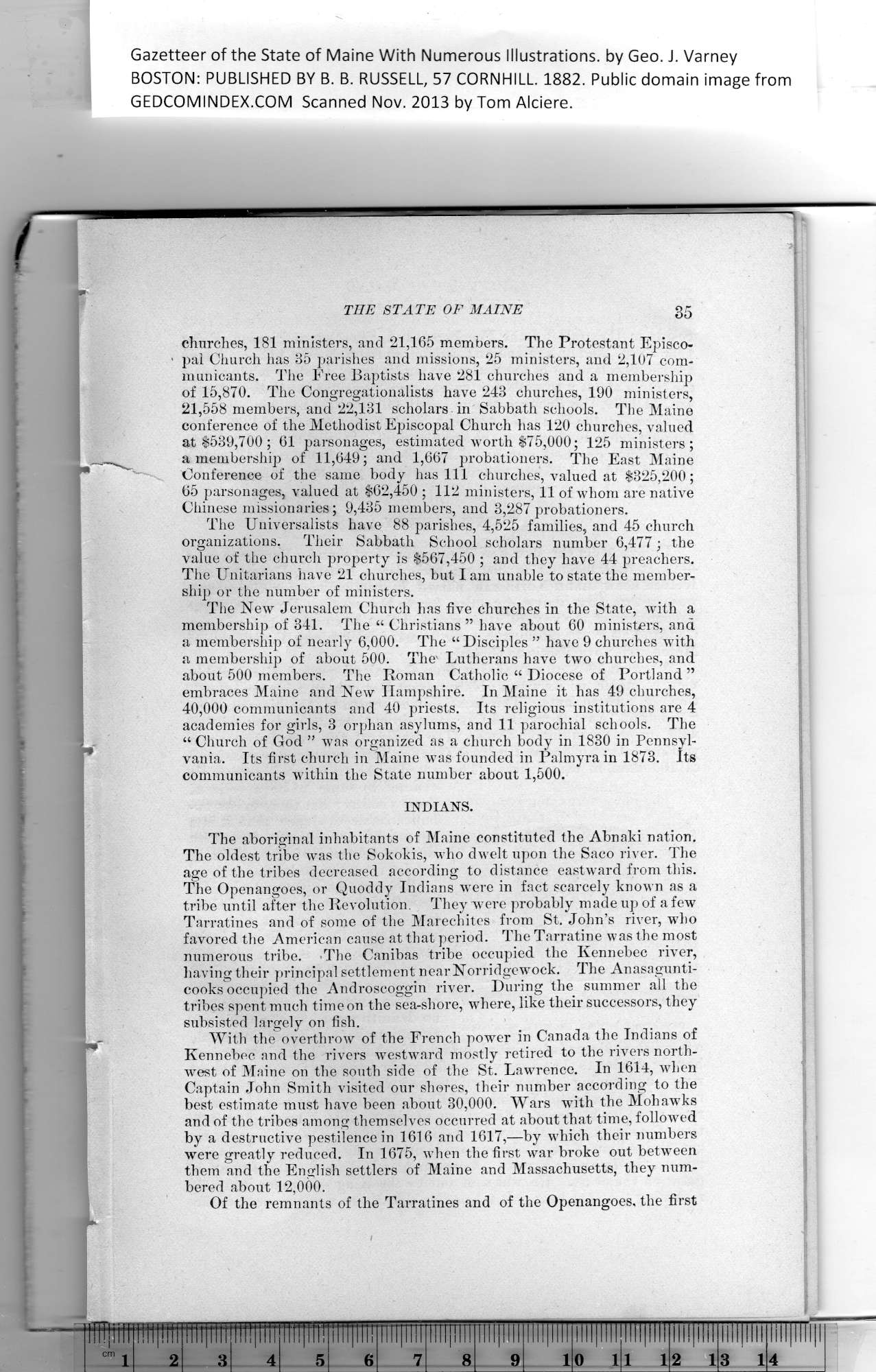|
Gazetteer of the State of Maine With Numerous Illustrations, by Geo. J. Varney
BOSTON: PUBLISHED BY B. B. RUSSELL, 57 CORNHILL. 1882. Public domain image from
THE STATE OF MAINE 35
churches, 181 ministers, and 21,165 members. The Protestant Episco-
pal Church lias 35 pjarishes and missions, 25 ministers, and 2,107 com-
municants. The Free Baptists have 281 churches and a membership
of 15,870. The Congregationalists have 243 churches, 190 ministers,
21,558 members, and 22,131 scholars in Sabbath schools. The Maine
conference of the Methodist Episcopal Church has 120 churches, valued
at $539,700; 61 parsonages, estimated worth $75,000; 125 ministers;
a membership of 11,649; and 1,667 probationers. The East Maine
Conference of the same body has 111 churclies, valued at $325,200;
65 parsonages, valued at $62,450 ; 112 ministers, 11 of whom are native
Chinese missionaries; 9,435 members, and 3,287 probationers.
The Universalists have 88 parishes, 4,525 families, and 45 church
organizations. Their Sabbath School scholars number 6,477; the
value of the church property is $567,450 ; and they have 44 preachers.
The Unitarians have 21 churches, but lam unable to state the member-
ship or the number of ministers.
The New Jerusalem Church has five churches in the State, with a
membership of 341. The “ Christians ” have about 60 ministers, and
a membership of nearly 6,000. The “ Disciples ” have 9 churches with
a membership of about 500. The- Lutherans have two churches, and
about 500 members. The Roman Catholic “ Diocese of Portland”
embraces Maine and New Hampshire. In Maine it has 49 churches,
40,000 communicants and 40 priests. Its religious institutions are 4
academies for girls, 3 orphan asylums, and 11 parochial schools. The
“ Church of God ” was organized as a church body in 1830 in Pennsyl-
vania. Its first church in Maine was founded in Palmyra in 1873. Its
communicants within the State number about 1,500.
INDIANS.
The aboriginal inhabitants of Maine constituted the Abnaki nation.
The oldest tribe was the Sokokis, who dwelt upon the Saco river. The
age of the tribes decreased according to distance eastward from this.
The Openangoes, or Quoddy Indians were in fact scarcely known as a
tribe until after the Revolution. They were probably made up of a few
Tarratines and of some of the Marechites from St. John’s river, who
favored the American cause at that period. The Tarratine was the most
numerous tribe. The Canibas tribe occupied the Kennebec river,
having their principal settlement near Norridgewock. The Anasagunti-
cooks occupied the Androscoggin river. During the summer all the
tribes spent much time on the sea-shore, where, like their successors, they
subsisted largely on fish.
With the overthrow of the French power in Canada the Indians of
Kennebec and the rivers westward mostly retired to the rivers north-
west of Maine on the south side of the St. Lawrence. In 1614, when
Captain John Smith visited our shores, their number according to the
best estimate must have been about 30,000. Wars with the Mohawks
and of the tribes among themselves occurred at about that time, followed
by a destructive pestilence in 1616 and 1617,—by which their numbers
were greatly reduced. In 1675, when the first war broke out betwreen
them aud the English settlers of Maine and Massachusetts, they num-
bered about 12,000.
Of the remnants of the Tarratines and of the Openangoes, tbe first
PREVIOUS PAGE ... NEXT PAGE
This page was written in HTML using a program written in Python 3.2
|
